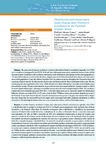Use este identificador para citar ou linkar para este item:
http://www.alice.cnptia.embrapa.br/alice/handle/doc/1033599Registro completo de metadados
| Campo DC | Valor | Idioma |
|---|---|---|
| dc.contributor.author | TOMAS, W. M. | pt_BR |
| dc.contributor.author | CAMILO, A. R. | pt_BR |
| dc.contributor.author | RIBAS, C. | pt_BR |
| dc.contributor.author | LEUCHTENBERGER, C | pt_BR |
| dc.contributor.author | BORGES, P. A. L | pt_BR |
| dc.contributor.author | MOURAO, G. | pt_BR |
| dc.contributor.author | PELLEGRIN, L. A. | pt_BR |
| dc.date.accessioned | 2016-01-12T11:11:11Z | pt_BR |
| dc.date.available | 2016-01-12T11:11:11Z | pt_BR |
| dc.date.created | 2016-01-12 | pt_BR |
| dc.date.issued | 2015 | pt_BR |
| dc.identifier.citation | The Latin American Journal of Aquatic Mammals, v. 10, n. 2, p. 107-114, dez. 2015. | pt_BR |
| dc.identifier.uri | http://www.alice.cnptia.embrapa.br/alice/handle/doc/1033599 | pt_BR |
| dc.description | The giant otter (Pteronura brasiliensis) is listed as vulnerable in Brazil, is included in Appendix I of CITES and is classified as endangered by the IUCN. In Brazil, few viable populations persist outside the Amazon basin and the Pantanal wetland. Furthermore, there is limited information on the distribution and abundance of the existing populations. The aim of this study was to estimate the abundance of giant otters in the Pantanal wetland and to discuss the conservation status of this population. From July 2000 to November 2011 we conducted surveys throughout the Pantanal to detect the occurrence of giant otters by the observations of active dens and latrines and the direct visualization of the otters. We also monitored giant otter population in five rivers, which allowed us to obtain information on number of individuals, group size and linear density. The species was found to occur in almost every river stretch within the Pantanal wetland, as well as in several aquatic habitat types, indicating a remarkable recovery since the over-hunting during the 1960s. The population of giant otter in the Pantanal may reach 3969 (SD = 1103) individuals, based on our estimated number of individual per kilometer of rivers and creeks (0.54 ± 0.15), over a total of about 7350km of rivers and secondary channels occurring in the Pantanal. These results indicate that the Pantanal is an important area to preserve the giant otter and its habitat, despite the many threats that the species still faces in the region, such as increased vessel traffic, pollution and siltation, as well as disruption of the hydrological characteristics due to the construction of dams and river-bed sedimentation. | pt_BR |
| dc.language.iso | eng | eng |
| dc.rights | openAccess | eng |
| dc.subject | Ariranha | pt_BR |
| dc.subject | Conservação de espécie | pt_BR |
| dc.title | Distribution and conservation status of giant otter Pteronura brasiliensis in the Pantanal wetland, Brazil. | pt_BR |
| dc.type | Artigo de periódico | pt_BR |
| dc.date.updated | 2017-07-25T11:11:11Z | pt_BR |
| dc.subject.thesagro | Espécie nativa | pt_BR |
| dc.subject.thesagro | Habitat | pt_BR |
| dc.subject.nalthesaurus | Pteronura brasiliensis | pt_BR |
| dc.subject.nalthesaurus | Indigenous species | pt_BR |
| dc.subject.nalthesaurus | Wetland conservation | pt_BR |
| riaa.ainfo.id | 1033599 | pt_BR |
| riaa.ainfo.lastupdate | 2017-07-25 | pt_BR |
| dc.identifier.doi | 10.5597/lajam 00202 | pt_BR |
| dc.contributor.institution | WALFRIDO MORAES TOMAS, CPAP; André Restel Camilo, Estagiário Embrapa Pantanal; Carolina Ribas, Instituto Nacional de Pesquisas da Amazônia-INPA; Caroline Leuchtenberger, Instituto Nacional de Pesquisas da Amazônia-INPA; Paulo André Lima Borges, Estagiário da Embrapa Pantanal; GUILHERME DE MIRANDA MOURAO, CPAP; LUIZ ALBERTO PELLEGRIN, CPAP. | pt_BR |
| Aparece nas coleções: | Artigo em periódico indexado (CPAP)  | |
Arquivos associados a este item:
| Arquivo | Descrição | Tamanho | Formato | |
|---|---|---|---|---|
| tomas2015.pdf | 905,23 kB | Adobe PDF |  Visualizar/Abrir |









